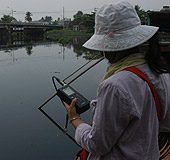Domestic wastewater in the drainage system of Ho Chi Minh City is currently a very serious issue, posing a high risk of pollution to surface water sources in the Saigon River.
 |
|
Pollution indicators increase with each inspection (Photo: B.Trung) |
As reported multiple times by the Labor Newspaper, during a meeting with the Economic and Budget Committee of the Ho Chi Minh City People’s Council on the morning of July 25, the Department of Natural Resources and Environment (DoNRE) continued to present shocking figures regarding water pollution.
Polluted canals increased 95,000 times
In a recent series on environmental pollution, the Labor Newspaper highlighted the “dead canals” in the urban area. A survey conducted in the first six months of 2006 by the Environmental Protection Sub-department confirmed that the pollution levels in the Tau Hu – Ben Nghe canal system had increased from 19,000 to 95,000 times compared to the first half of 2005. Specifically, the Tan Hoa – Lo Gom canal, which is the most heavily polluted, showed BOD5 levels fluctuating between 90 mg/l and 164 mg/l during the first half of the year, far exceeding permissible standards. The dissolved oxygen (DO) level has been at zero since 2001, indicating that this canal system is effectively dead and no longer capable of self-purification. Environmental experts warn that domestic wastewater in the drainage system of Ho Chi Minh City is currently a very serious issue, posing a high risk of pollution to surface water sources in the Saigon River.
Shocking hospital wastewater
According to a survey by the Environmental Protection Sub-department, Ho Chi Minh City currently has 109 hospitals and medical centers, including 83 hospitals, mainly concentrated in districts 1, 3, 5, 10, and Tan Binh. The total wastewater generated by these hospitals and medical centers is approximately 17,276 m3 per day, but the majority is not treated adequately. Wastewater from laundry, sanitation of medical staff, testing, and surgery is heavily polluted with microorganisms and organic matter, with concentrations exceeding permissible standards by 100 to 1,000 times. Currently, only about 3,120 m3 of wastewater per day is treated to meet environmental standards, and only 78 out of 109 hospitals and medical centers have wastewater treatment systems.
Mr. Nguyen Van Chien, Deputy Director of the DoNRE, stated that there are two main reasons for the high volume of medical wastewater and ineffective treatment. Firstly, there has not been adequate investment in the operation and maintenance of wastewater treatment systems, many of which are severely degraded and must cease operations. Additionally, due to the rising demand for medical services, many facilities have increased their capacity without synchronously investing in wastewater treatment systems.
Commenting on the wastewater treatment situation in healthcare facilities, Mr. Huynh Cong Hung, Deputy Head of the Economic and Budget Committee of Ho Chi Minh City People’s Council, expressed significant concern. He recounted: “During one inspection of healthcare facilities, the team discovered a health station in one district of the city had three septic tank trucks “sheltering” right within the station’s premises!”
Groundwater and surface water are both in S.O.S!
According to monitoring documents from 2000 to the present, groundwater levels in aquifers are increasingly declining, posing a risk of depletion. The lowered water levels have led to saltwater intrusion and pollution entering the aquifers, as well as the risk of land subsidence due to the depletion of groundwater. Groundwater at monitoring stations such as Truong Tho and Linh Trung has iron content exceeding permissible standards and is higher than levels recorded in the first half of 2005. More seriously, the shallow groundwater at the Binh Hung station has been heavily contaminated with sulfur.
Similarly, the surface water in the Saigon River and Dong Nai River at the lower reaches is also becoming increasingly polluted. Analysis results of coliform bacteria in the first half of the year at monitoring stations on the Dong Nai River showed a 50-fold increase compared to the previous year. According to assessments from environmental agencies, monitoring stations at Phu Cuong, Binh Phuoc, and Phu An (Saigon River) are also contaminated with organic matter, oil, and microorganisms.


















































